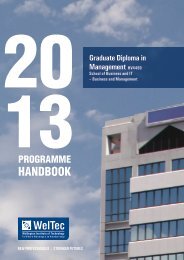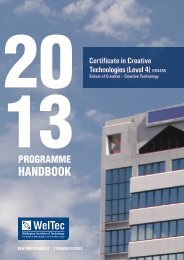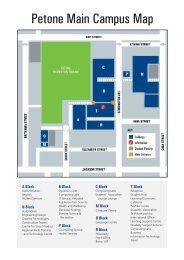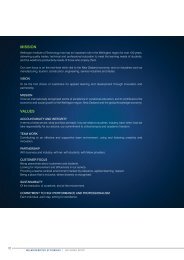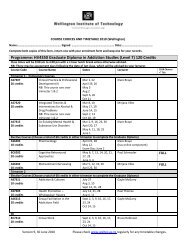HANDBOOK - Wellington Institute of Technology
HANDBOOK - Wellington Institute of Technology
HANDBOOK - Wellington Institute of Technology
- No tags were found...
You also want an ePaper? Increase the reach of your titles
YUMPU automatically turns print PDFs into web optimized ePapers that Google loves.
PROGRAMME<strong>HANDBOOK</strong>Certificate in NetworkAdministration (Level 6) HV4247School <strong>of</strong> Business and IT – Information <strong>Technology</strong>
DisclaimerThe information contained in this Programme Handbook is correct at the time <strong>of</strong> publication. However, programmes and coursesare subject to change and WelTec reserves the right to change the content, location or method <strong>of</strong> presentation <strong>of</strong> anyprogramme or course, and update this Programme Handbook accordingly at any time. The online edition <strong>of</strong> the ProgrammeHandbook is the <strong>of</strong>ficial Programme Handbook.Copyright © 2013<strong>Wellington</strong> <strong>Institute</strong> <strong>of</strong> <strong>Technology</strong> owns copyright in this programme handbook. No part may be reproduced, stored in a retrievalsystem or <strong>of</strong>fered for resale without WelTec’s written permission.<strong>Wellington</strong> <strong>Institute</strong> <strong>of</strong> <strong>Technology</strong> - 2013 Programme Handbook February 2013HV4247 Certificate in Network Administration (Level 6)
School <strong>of</strong> Business and ITPROGRAMME <strong>HANDBOOK</strong> 2013HV4247Certificate in Network Administration(Level 6)<strong>Wellington</strong> <strong>Institute</strong> <strong>of</strong> <strong>Technology</strong> - 2013 Programme HandbookHV4247 Certificate in Network Administration (Level 6)Publication Date: 4 March 2013
HAERE MAIWhai korōria ki te atua i runga rawaMaunga rongo ki te whenuaWhakaaro pai ki ngā Tangata Katoa.Tena Koutou Katoa,Tēnei te mihi atu ki a koutou ngā Tauira oTe Whare Wananga o Te Awakairangi.Nau mai haere mai ki tēnei Wananga o tātou.Kia kaha koutou ki te whai mātauranga i tēnei tau, ki te whakarongohoki ki ō koutou kaiako.“Whāia te kotahitanga o te wairua.Mā te rangimārie me te aroha e paihere”(pursue unity <strong>of</strong> spirit, which is bound together by peace and aroha)He mihi nui tēnei kia koutou ngā Tauira oTe Whare Wananga o Te Awakairangi.Nau mai haere mai ki tēnei Whare Wananga o tātou.<strong>Wellington</strong> <strong>Institute</strong> <strong>of</strong> <strong>Technology</strong> - 2013 HV4247 Programme Handbook February 2013Overview and Programme Specific Information Page 4
CONTENTSHAERE MAI............................................................................................................................................. 4CHIEF EXECUTIVE’S WELCOME ......................................................................................................... 6EXECUTIVE DEAN’S WELCOME .......................................................................................................... 7INTRODUCTION ..................................................................................................................................... 7ACADEMIC CALENDAR - 2013 ............................................................................................................. 8STAFF ................................................................................................................................................... 10AIMS ...................................................................................................................................................... 11GRADUATE PROFILE .......................................................................................................................... 11CAREERS ............................................................................................................................................. 11STAIRCASING ...................................................................................................................................... 11PROGRESS THROUGH THE PROGRAMME ..................................................................................... 12GRADUATION CRITERIA .................................................................................................................... 12LEARNING AND TEACHING................................................................................................................ 12ASSESSMENT PROCEDURES ........................................................................................................... 12Assessment Rationale ................................................................................................................ 13Assessment Schedule ................................................................................................................ 14Format Of Assessments ............................................................................................................. 14Assessment Cover Sheets ......................................................................................................... 14Submitting Assessment And Assignment Work ......................................................................... 14Arranging for Late Submission Of Assessments ........................................................................ 14Applying For An Extension Beyond The Course End Date ........................................................ 14Penalty for Unarranged Late Submission ................................................................................... 15Absence From Supervised Assessments ................................................................................... 15Reassessment Of Assessments ................................................................................................. 15Assessment Results Notification ................................................................................................ 15Challenging Assessment Decisions ............................................................................................ 15External Examinations ................................................................................................................ 16RISK MANAGEMENT, SAFETY AND HEALTH ................................................................................... 16ATTENDANCE MATTERS .................................................................................................................... 16REQUIRED TEXTS ............................................................................................................................... 16STATIONERY REQUIREMENTS ......................................................................................................... 16OFF-SITE PRACTICAL AND WORKPLACE COMPONENTS ............................................................. 16EMPLOYMENT ..................................................................................................................................... 17INFORMED CONSENT AND CONFIDENTALITY................................................................................ 17PROGRAMME EVALUATION .............................................................................................................. 17COURSE DESCRIPTORS .................................................................................................................... 18<strong>Wellington</strong> <strong>Institute</strong> <strong>of</strong> <strong>Technology</strong> - 2013 HV4247 Programme Handbook February 2013Overview and Programme Specific Information Page 5
WELCOME TO WELTECCHIEF EXECUTIVE’S WELCOMEGreetings, Kia Ora, Tal<strong>of</strong>a Lava, Kia Orana, ni sa Bula VinakaKaise Hai, Sat sri akal, Malo e Lelei, Halo Olgeta, Taloha niMarhaba, Bozu, Fakal<strong>of</strong>a Lahi Atu, Annyong haseyo, Ni hao, NamasteWelcome to <strong>Wellington</strong> <strong>Institute</strong> <strong>of</strong> <strong>Technology</strong>Te Whare Wananga o te AwakairangiIn selecting to learn at <strong>Wellington</strong> <strong>Institute</strong> <strong>of</strong> <strong>Technology</strong> (WelTec), you have chosen a place <strong>of</strong>learning that aims to give you not only the working lifestyle you want, but also, a friendly andcomfortable environment where you can feel at home.By enrolling at WelTec, you are setting out on a learning journey. What you learn and for whatpurpose, are your decisions to make. We want to walk beside you as your coach, partner andmentor; <strong>of</strong>fering support, facilities, opportunities, tools and information to help you reach yourgoals.When you enrol, you will find that the majority, or maybe all, <strong>of</strong> your courses take place on onecampus. Whether your classes are held at our <strong>Wellington</strong> sites, in Auckland, Christchurch, any <strong>of</strong> ourPetone or other sites, all are your campuses.With your Student ID card, all services and facilities are there for you to use.Please let us know if you have any queries or needs we haven’t yet met. Best wishes for a happy andsuccessful year.Linda Sissons (Dr)Chief Executive<strong>Wellington</strong> <strong>Institute</strong> <strong>of</strong> <strong>Technology</strong> - 2013 HV4247 Programme Handbook February 2013Overview and Programme Specific Information Page 6
EXECUTIVE DEAN’S WELCOMEWelcome to WelTec – your place for learning. As an institute <strong>of</strong> learning you, as a student, are ourkey priority.All staff at WelTec have one primary focus and that is to help facilitate your learning. As youprogress through your studies please take the opportunity to access the facilities and staff supportavailable.Your success is our success.Julia Hennessy (MEd, MMgt, PGDipHSM, BA, DipN)Executive DeanINTRODUCTIONThis Programme Handbook is intended to provide information relating to the programme youare enrolled in with WelTec. There is also an associated WelTec A-Z site that has otherhelpful information regarding systems and processes that operate at WelTec.The most up-to-date version <strong>of</strong> this Programme Handbook and the WelTec A-Z generalinformation is online at:http://www.weltec.ac.nz/SH/HV4247.pdfWelTec’s policies that apply to students and this Programme Handbook are located at:http://www.weltec.ac.nz/SH/Policy/<strong>Wellington</strong> <strong>Institute</strong> <strong>of</strong> <strong>Technology</strong> - 2013 HV4247 Programme Handbook February 2013Overview and Programme Specific Information Page 7
TRIMESTER THREE – 2013TeachingPeriodWeekNoMondaydate40 30-Sep41 7-OctMON TUE WED THU FRI SAT SUN42 14-Oct Tri 2 43 21-Oct Study Break Study Break Study Break Study Break Study Break44 28-Oct Labour Day45 4-NovExam Week246 11-Nov Tri 3 Starts47 18-NovExam Week1Exam Week2Exam Week1Exam Week2Exam Week1Exam Week2Exam Week1Tri 2 EndsCanterburyAnniversary Tri 2Tri2 ResultsCompleted48 25-Nov49 2-Dec50 9-Dec51 16-Dec52 23-Dec WelTec closed for Christmas130-Dec-132 6-Jan-143 13-Jan Tri 2+3 4 20-Jan5 27-Jan<strong>Wellington</strong>AnniversaryAucklandAnniversaryWelTec closed for New Year Holidays6 3-Feb Tri 3 Waitangi Day7 10-Feb8 17-Feb9 24-Feb Tri 3 Ends10 3-Mar Tri 1 Starts11 10-MarTri 3 ResultsCompleted Enr period Last date to change or withdraw in that enrolment period with refundEnr periodLast date to withdraw (75% <strong>of</strong> course enrolment period)The up-to-date, day-to-day and week-by-week timetables are located at:http://timetable.weltec.ac.nz/.<strong>Wellington</strong> <strong>Institute</strong> <strong>of</strong> <strong>Technology</strong> - 2013 HV4247 Programme Handbook February 2013Overview and Programme Specific Information Page 9
STAFFFaculty Executive Dean:Julia HennessySchool:Business and ITHead <strong>of</strong> School:Mick JaysPhone/extension 670E-mailmick.jays@weltec.ac.nzAssociate Head <strong>of</strong> School: TBAPhone/extensionTBAE-mailTBASchool Business Administrator: Michele CarrollPhone/extension 515E-mailMichele.Carroll@weltec.ac.nzStaff Member Qualifications Position Email AddressALLSOBROOK, PhD SASM Anthony.Allsobrook@weltec.ac.nzAnthony DrARMSTRONG, Ian MComm, BAppIS,PASM Ian.Armstrong@weltec.ac.nzDipAdEd, CCNP, CCAI,MCTS, NZCEBEDI, SunilPGCertBusAd, BIT, ASM Sunil.Bedi@weltec.ac.nzDipAirTechOpsBRYANT, PaulBSocSc, CCAI, CCNP, SASM Paul.Bryant@weltec.ac.nzMCSE, DipAdEdTrainEALES, Andrew MSc, MMus SASM Andrew.Eales@weltec.ac.nzECHANO, Jeff BSc, CertSE ASM Jeff.Echano@weltec.ac.nzEYES, David CompTIA A+ ASM David.Eyes@weltec.ac.nzFARRELL, Mariki BA, CertAdultEd SASM Mariki.Farrell@weltec.ac.nzGOULD, JohnPGDipAppSci, BSc, NZCE, SASM John.Gould@weltec.ac.nzDipAdEdHUNTER, Ian MSc, NZCE, AdvTC, A/B PASM Ian.Hunter@weltec.ac.nzJEON, TerryMKnowMngt, DipBC, BSc SASM Terry.Jeon@weltec.ac.nz(Hons)KEATS, Evan BA, CertAdEd, NZCE ASM Evan.Keats@weltec.ac.nzMcKINLAY, Steve MA, BBus SASM Steve.McKinlay@weltec.ac.nzMANUELI, Kerese Dr PhD, PGDipComp SASM Kerese.Manueli@weltec.ac.nzMORRIS, TimDipSysTech, DipCompEng, ASM Tim.Morris@weltec.ac.nzDiplComp, NZCE, A+,Network+OWEN, Rhys BSc (Hons) SASM Rhys.Owen@weltec.ac.nzRADEMEYER, Corrie BA ASM Corrie.Rademeyer@weltec.ac.nzSANTOS, Aristotle BSc, AutoCADD, MCP, ASM Aristotle.Santos@weltec.ac.nzPower ElectronicsCertificationSUDHAKAR, Clement MSc, BE ASM Clement.Sudhakar@weltec.ac.nzSUTCLIFFE, Robert PGDipInfoSysMngt, BSc, SASM Robert.Sutcliffe@weltec.ac.nzCATTROWER, Leonie BSW, DipAdEd, DipICT SASM Leonie.Trower@weltec.ac.nzTULLOCK, Nick MCP, NZCE SASM Nick.Tullock@weltec.ac.nz<strong>Wellington</strong> <strong>Institute</strong> <strong>of</strong> <strong>Technology</strong> - 2013 HV4247 Programme Handbook February 2013Overview and Programme Specific Information Page 10
AIMSTo provide a foundation <strong>of</strong> generic knowledge and skills suitable for entry into the area <strong>of</strong>network administration.To enable students to gain the expertise with Micros<strong>of</strong>t technologies that will help them todevelop into technical leaders capable <strong>of</strong> successfully implementing Micros<strong>of</strong>t businesssolutions.To provide a <strong>Wellington</strong> <strong>Institute</strong> <strong>of</strong> <strong>Technology</strong> certification that is valued in the marketplace to assist graduates in obtaining a job in the networking area.To prepare students for Micros<strong>of</strong>t network certification examinations.To provide a transition path when the previous track <strong>of</strong> the Programme is no longer <strong>of</strong>fered,so that students who do not complete the Programme under the previous track may stillcomplete the Programme.GRADUATE PROFILEThe CiNA and MCTS credentials are for individuals who have the skills to successfullyimplement a Micros<strong>of</strong>t product or technology as part <strong>of</strong> a business solution in anorganisation.Graduates will be pr<strong>of</strong>essionals who can implement, manage, and, troubleshoot existingnetwork and system environments based on Micros<strong>of</strong>t Windows platforms.The industry roles that a graduate will be capable <strong>of</strong> performing will vary widely, according tothe individual’s work experience, and will cover one or more <strong>of</strong> the following:• Help Desk operator.• Computer Support technician.• Junior Network Administrator.• Intermediate Network Administrator.• Senior Network Administrator.This qualification enables students to sit and achieve internationally recognised Micros<strong>of</strong>tcertifications.CAREERSThe industry roles that a graduate will be capable <strong>of</strong> performing will vary widely, according tothe individual’s work experience, and will cover one or more <strong>of</strong> the following:• Help Desk operator• Computer Support technician• Junior Network Administrator• Intermediate Network Administrator• Senior Network Administrator.STAIRCASINGSuccessful graduates are primarily expected to move into or advance within the work forceto fill one <strong>of</strong> the roles listed in Careers.They will also be in an ideal position to extend their studies and qualifications with:• Bachelor <strong>of</strong> Information <strong>Technology</strong> (<strong>Wellington</strong> <strong>Institute</strong> <strong>of</strong> <strong>Technology</strong>)<strong>Wellington</strong> <strong>Institute</strong> <strong>of</strong> <strong>Technology</strong> - 2013 HV4247 Programme Handbook February 2013Overview and Programme Specific Information Page 11
• Post-graduate work (if they already possess a degree)• MCITP certification• MCITP/DB certificationSuccessful CiNA graduates can gain 40 (unspecified) Level 6 Cross Credits in the Bachelor<strong>of</strong> Information <strong>Technology</strong> (WelTec).PROGRESS THROUGH THE PROGRAMMEEach course has one summative test. Each student will be marked on their test paper for eachtest as either Grade C or Grade NYC.Each student may if they are graded NYC in any test, apply to their Tutor for one (and onlyone) Resit test. The Resit may be granted at their Tutors discretion. The Tutor will use anattendance guideline <strong>of</strong> 80% when assessing a request for a Resit.GRADUATION CRITERIAThe Certificate in Network Administration (Level 6) will be awarded to students who gain a“C” Competent grade for the four summative tests that make up each track <strong>of</strong> the Programme.LEARNING AND TEACHINGThe following teaching and learning techniques will be used:LecturesTo impart the concepts, principles and knowledge detail.LaboratoriesTo acquire the practical skills and to consolidate the theory knowledge.Computer simulationsTo acquire the practical skills and to consolidate the theory knowledge.Class discussionsTo identify areas <strong>of</strong> weakness, to utilise student expertise and to consolidate the theoryknowledgePractice exam (formative) quizzesTo evaluate the progress <strong>of</strong> students and identify areas <strong>of</strong> weakness, to improve skill levelsand to consolidate the theory knowledgeCase studiesTo improve skill levels and to consolidate the theory knowledge.The ethics <strong>of</strong> s<strong>of</strong>tware piracy will arise at various stages <strong>of</strong> each <strong>of</strong>fering and will be dealtwith in a pr<strong>of</strong>essional and appropriate way by each Tutor involved.The theory taught along with the practical work will usually be combined and you will learntheory as you work through the practical work. This will be outlined in your course outlinegiven to you on the first day by your tutor.ASSESSMENT PROCEDURESYou need to become familiar with the assessment procedures for your courses and thisProgramme. Overall Programme procedures are given below. There may also be coursespecific assessment procedures and requirements noted in your Course Outlines.<strong>Wellington</strong> <strong>Institute</strong> <strong>of</strong> <strong>Technology</strong> - 2013 HV4247 Programme Handbook February 2013Overview and Programme Specific Information Page 12
Please note that all activities that contribute towards your final course grades, and thereforeyour qualification completion, are known as assessments (summative assessments to beprecise). There are many different types <strong>of</strong> assessment activities your tutors use in yourcourses.The WelTec Academic Regulations section 7 require that you:make yourself available to undertake all summative assessment items at the timeand place stipulated by the teaching staff responsible for the courseact with integrity (honesty) during assessments. You are expected to:o Submit material that is your own original worko Collaborate only as permittedo Acknowledge contributions from other sources by using APA reference format(failure to do this correctly may be regarded as plagiarism)o Keep written and electronic work secure to prevent others from accessing andcopying worko Understand the definition <strong>of</strong> academic dishonesty and the consequences <strong>of</strong>breaching the regulations (see Academic Regulations S12 Dishonest Practice).WelTec conducts assessments within rules set out in the following regulations and policies: The Academic Regulations 2013o Examination Ruleso Aegrotat regulationso Gradeso Resultso Challenging Assessment Decisionso Dishonest Practice in Assessmento Appeals Policy 3.05 Assessment Policyo Definitionso Guidelines for assessment practice Policy 3.07 Programme Moderation Policyo Quality assurance processes before using the assessment activityo Quality assurance processes after marking to verify marker’s consistencyYou may ask your tutors at any time about the quality-assured status <strong>of</strong> the assessmentactivities you are asked to complete.Assessment RationaleThe courses in this programme are assessed using competency-based methods.Assessments are in a written, oral or practical exercise format - including tests, essays,assignments, labs and projects. They may be closed book or open-book, or somecombination <strong>of</strong> resources as specified by the course tutor.Both formative and summative assessments are carried out in both Courses <strong>of</strong> the relevanttrack.Formative assessment are conducted during these Courses to assist students to:• Consolidate their knowledge and skills.• Evaluate their progress.• Become familiar with the specific skills required for the external examination.• Evaluate whether they have a reasonable likelihood <strong>of</strong> passing the external Micros<strong>of</strong>texam.Summative assessment is conducted at the conclusion <strong>of</strong> each Course and will relate to thelearning outcomes <strong>of</strong> the Course. The results <strong>of</strong> this assessment do not guarantee theoutcome <strong>of</strong> sitting the related external Micros<strong>of</strong>t exam.<strong>Wellington</strong> <strong>Institute</strong> <strong>of</strong> <strong>Technology</strong> - 2013 HV4247 Programme Handbook February 2013Overview and Programme Specific Information Page 13
Assessment types and procedures are designed to be fair to students <strong>of</strong> both genders, fromall cultural backgrounds and not to disadvantage any particular group.Assessment ScheduleAs every course is internally assessed, assessments may occur at any time while the courseis being taught. The assessments are specified in the course outline and discussed in class.Where different from the course outline, you will be given notice (see the School noticeboard) at least five working days prior to the assessment. This notice will specify:• The course name and number• The nature <strong>of</strong> the assessment• The date an assignment is due or test is to be sat.Format Of AssessmentsPlease refer to your Course Outline for the Assessment Schedule for each <strong>of</strong> your Courses.The Schedule will detail the assessment type (test, assignment, presentation, etc), the topicbeing assessed, due dates, and if appropriate the weighting. Any other conditions will alsobe noted as they apply to the assessments for that course.Assessment Cover SheetsA Student Assessment Cover Sheet must be attached to all assessments handed/posted in.If you’re on campus you can find this form on the Student Intranet:1. Click on Forms and Documents > Assessment Forms2. Click on Student Assignment Cover Sheet – ASF0073. Print <strong>of</strong>f the form.If you are not on campus you can access them on the WelTec website:a. Go to the WelTec website: www.weltec.ac.nz/PH/b. Use the CITRIX link to login to WelTec's intranet (see the A-Z for details)c. Use instructions 1-3 above to print the cover sheet.Submitting Assessment And Assignment WorkIt is essential that you meet the assessment submission deadlines notified in your CourseOutlines' assessment schedules - unless you have pre-arranged for a late submission withyour tutor. Please refer to your course outlines for any penalties for late submission <strong>of</strong>assessments.Some assessments may have time-related criteria attached to them. Your course outline willnotify you <strong>of</strong> these particular assessments, and the reasons for the time criteria. Lateness,absence or early departure from these assessments may carry specific penalties.Arranging for Late Submission Of AssessmentsIn case <strong>of</strong> illness, injury or exceptional circumstances you may request to make asubmission after the assessment due date by submitting a Request for Late SubmissionForm prior to the due date. On receiving your Request, your tutor may negotiate a newsubmission date/time. Where work has been handed in late without approval, lateassessment submission provisions will apply.Applying For An Extension Beyond The Course End DateIf you are prevented by illness, injury or exceptional circumstances from completing anassessment by the course end date, you may apply to the Associate Head <strong>of</strong> School for anextension to complete the assessment.<strong>Wellington</strong> <strong>Institute</strong> <strong>of</strong> <strong>Technology</strong> - 2013 HV4247 Programme Handbook February 2013Overview and Programme Specific Information Page 14
The application is to be made in writing as soon as possible and not later than 48 hoursbefore the assessment due time and date. The application is made on the WelTec CourseExtension Form available from the Student Information Centre and the WelTec website.Where there are valid reasons, the Associate Head <strong>of</strong> School may grant an extension for aperiod <strong>of</strong> no more than three weeks after the course end date. A longer than three weeks’extension may be recommended by the Associate Head <strong>of</strong> School to the Board <strong>of</strong> Studies'Achievement Sub-Committee for approval, where there are extenuating circumstances thatjustify a longer extension.Penalty for Unarranged Late SubmissionThere will be no late submissions without an agreed arrangement.Absence From Supervised AssessmentsStudents who do not turn up for a test will be graded as NYC except where suitable reasonis shown, in which case a deferred test will be run.Suitable reasons include:1. They produce an appropriate medical certificate.2. Special circumstances such as bereavement, accident, etc.Reassessment Of AssessmentsGenerally, one resit will be available for students who do not pass an assessment element atthe first attempt, although further resit/s may be granted at the discretion <strong>of</strong> the AssociateHead <strong>of</strong> School.This is at the discretion <strong>of</strong> the Associate Head <strong>of</strong> School.Assessment Results NotificationCourse assessment and final grades are reported using the Grade Key 1 method. GradeKeys are explained in Appendix 2 <strong>of</strong> the Academic Regulations.Once your tutor has marked your assessments you will be notified <strong>of</strong> your result.• If the assessment is in the form <strong>of</strong> a practical in-class demonstration/observation, you arelikely to get your results immediately or shortly after the assessment activity has concluded.• If the assessment is a supervised test you are able to review your work, but theassessment is collected and retained by WelTec.• If you hand in an assignment it is returned to you along with feedback to explain thereason(s) for the assessment result.• If you sit a final exam you are able to view your result online at the student results portal:https://results.weltec.ac.nz within 15 working days.Results for each assessment are available within 15 working days on WelTec's StudentResults portal at: https://results.weltec.ac.nz.Use your normal WelTec login and password to access a number <strong>of</strong> items, such as yourassessment results, current course enrolments, and other details.Challenging Assessment DecisionsIf you have reason to believe that the grade or mark for a particular assessment is incorrect,you should firstly discuss this with your tutor within five (5) working days <strong>of</strong> the return <strong>of</strong> theassessment.Your tutor will provide feedback to clarify why the grade or mark has been awarded andmay, if justified, amend the result.If you still believe that the mark or grade is incorrect, you should discuss the matter with theAssociate Head <strong>of</strong> School.<strong>Wellington</strong> <strong>Institute</strong> <strong>of</strong> <strong>Technology</strong> - 2013 HV4247 Programme Handbook February 2013Overview and Programme Specific Information Page 15
For more information on Challenging Assessment Decisions please refer to the WelTecAcademic Regulations 2013 - section 11.External ExaminationsIndependent <strong>of</strong> CiNA, external (Micros<strong>of</strong>t) certification examinations can be booked and satunder the independent auspices <strong>of</strong> a Micros<strong>of</strong>t accredited testing centre who administer theexams on behalf <strong>of</strong> Micros<strong>of</strong>t.RISK MANAGEMENT, SAFETY AND HEALTHWelTec students share the responsibility <strong>of</strong> maintaining a safe and healthy workingenvironment whether on campus or studying <strong>of</strong>f-site (See Student Code <strong>of</strong> Conduct, Section3.4).ATTENDANCE MATTERSAn objective <strong>of</strong> study with WelTec is to prepare you for your career in industry. Your attitude,attendance and behaviour are important. Please give your best effort and ensure yourbehaviour and attendance reflect your desire to do well.You should therefore be present on time, fully equipped and, if applicable, dressed andgroomed appropriately for practical sessions.You are expected to attend all classes and assessments as timetabled. If you are not able toattend then you should notify your course tutor.Note that a student on student allowances/living costs who does not:• meet prescribed attendance requirements, and/or• disengages in their learning and assessments, and• does not respond to contact from the institute,will be notified to Academic Records and Administration. It is your responsibility to informStudyLink if you change your study details.All daytime classes will have a common start time on the hour and must finish by 50 minutespast the hour, to allow time for students and staff to arrive at their next class on time.REQUIRED TEXTSYour Course Descriptors may identify some text books as required, and/or recommendedtextbooks. Please refer to your Course Outlines for the most up-to-date edition information.Textbooks are available for purchase from vicBooks, <strong>Wellington</strong>, or as specified in theCourse Outlines.STATIONERY REQUIREMENTSYou are required to provide items, such as stationery, for your study programme. Tutors willconfirm with you where other equipment and/or materials are required for specific courses orclasses.OFF-SITE PRACTICAL AND WORKPLACE COMPONENTSThere are no <strong>of</strong>f-site practical/workbased components in the programme.<strong>Wellington</strong> <strong>Institute</strong> <strong>of</strong> <strong>Technology</strong> - 2013 HV4247 Programme Handbook February 2013Overview and Programme Specific Information Page 16
EMPLOYMENTThe School does not provide jobs or search for jobs for students. However, any vacancieswe received will be posted on the 7th floor Notice Board.INFORMED CONSENT AND CONFIDENTALITYYou will be asked to complete a consent form if your photograph is to be used in any WelTecliterature.All personal information collected and stored by WelTec is kept confidential.PROGRAMME EVALUATIONWelTec is interested in the experience students have during their time studying. As well asinformal conversations with students, there are three main surveys available to students toexpress their views and rate WelTec services.As a student new to WelTec:In the first few weeks you will be invited to participate in the WelTec EV1 - First Impressionssurvey (www.surveymonkey.com/s/WelTecEV1). This is open to first-time WelTec students,and asks for your rating <strong>of</strong> and views about your enrolment experience, the initial in-classexperience, and also your experience <strong>of</strong> our online resource systems, Moodle or LearnZone.During your course time:Your course outline may indicate that your course will have an EV4 - Teacher and CourseEvaluation undertaken towards the end. This helps the Programme Team to improve theteaching, the course, and the value <strong>of</strong> the Programme to students. Note: you will need aspecific 'survey event code' supplied by the survey administrator to use the EV4.At the end <strong>of</strong> the programme or year:In the final few weeks <strong>of</strong> the programme, or year, you will be invited to participate in the EV3- Student Satisfaction Survey (www.surveymonkey.com/s/WelTecEV3). This asks you aboutyour overall experience <strong>of</strong> WelTec's services, the programme, teaching, skills development,career enhancement, and overall satisfaction.All WelTec surveys are anonymous; we do not ask you for identification. We do however askfor some demographic information (age range, sex, enrolment types, ethnicity, etc.) in orderto make sense <strong>of</strong> trends for particular learner groups.The outcomes <strong>of</strong> the surveys are reported as aggregated information and tables to theWelTec Academic Committee. The reports are also made available to students.<strong>Wellington</strong> <strong>Institute</strong> <strong>of</strong> <strong>Technology</strong> - 2013 HV4247 Programme Handbook February 2013Overview and Programme Specific Information Page 17
COURSE DESCRIPTORSCourse Descriptors are the formally approved documents that describe:The course title, level, credit valueThe aims <strong>of</strong> the courseWhat you will be learning – the Learning Outcomes that guide the content andprocess <strong>of</strong> your learning experiences and activities with your tutorThe assessment activities you need to complete to show how well you havedeveloped your skills and knowledge against the requirements <strong>of</strong> the LearningOutcomesThe texts or resources that you are required to purchase. Note: for some courses thelatest texts may be listed either in the Required Texts section above, or in yourCourse Outline. If you are not certain, clarify the text or edition with your tutor.Any external standards that the course is also meeting the requirements <strong>of</strong> (may beunit standards, pr<strong>of</strong>essional bodies, vendor certifications, etc.)Course Outlines, which your tutors will provide to you in class, or through LearnZone orMoodle, contextualise the Descriptors for your particular class for this year. The Outlineshould provide you with tutor information, specific course topic schedules, assessmentdates, specific rules and requirements, and other useful information.The course descriptors for this programme make up the rest <strong>of</strong> this Programme Handbookon the following pages.Note: Please be aware that it may be that not all courses listed are be <strong>of</strong>fered in any giventrimester or year. For further information on this please contact your Student Advisor.<strong>Wellington</strong> <strong>Institute</strong> <strong>of</strong> <strong>Technology</strong> - 2013 HV4247 Programme Handbook February 2013Overview and Programme Specific Information Page 18
COURSE TITLE:Course Number:Micros<strong>of</strong>t Windows ClientNA6009Level: 6Credits: 10Pre or Co requisites:Learning Hours: (Complete for eachdelivery mode)Face-to-face tuition 45Self-directed with tutorial supportavailableOnlineDistance (not online)Resource based learning (notonline)Workplace learningSupervised work experienceSelf-directed (out <strong>of</strong> class without directtutorial support)55Workplace projectTests and examinationsOther(State)……………………………..Total learning hours 100Aim(s):Upon completion <strong>of</strong> the course, the student will:1. Be able to install a Windows operating system or perform an upgrade from a previousversion <strong>of</strong> Windows, and migrate user pr<strong>of</strong>iles.2. Be able to capture a system image, and configure a VHD.3. Be able to prepare a system image for deployment and deploy it.4. Be able to configure devices and manage disks.5. Be able to configure application compatibility and restrictions.6. Be able to configure IPv4; IPv6 and other networking settings.
7. Be able to configure Windows Firewall and Remote Management.8. Be able to configure shared resources.9. Be able to configure authentication and authorisation.10. Be able to configure remote connections.11. Be able to configure disk encryption.12. Be able to configure internet browser settings.13. Be able to monitor systems and configure performance settings.14. Be able to configure backup, system recovery, and file recovery options.Topic(s) or summary <strong>of</strong> content:1. Installing and/or upgrading Windows Operating System2. Deploying a Windows Operating system3. Configuring Hardware and Applications4. Configuring network connectivity5. Configuring access to resources6. Configuring Mobile Computing7. Monitoring and Maintaining Systems8. Configuring Backup and Recovery optionsTopic 1:Installing and/or upgrading a Windows operating systemLearning Outcome(s):Perform a clean installationUpgrade to Windows operating system from a previous versionAssessment criteria: (Include links to unit standards where appropriate)The student is able to: Identify hardware requirements Perform a clean installation Set up a Windows Operating System as the sole operating system or as dual boot Prepare an installation source: USB, CD, network share, WDS Upgrade from a previous version <strong>of</strong> Windows and upgrade from one edition toanother Migrate from previous versions <strong>of</strong> Windows from one machine to another
Topic 2:Deploying a Windows Operating SystemLearning Outcome(s):Capture a system imagePrepare a system image for deploymentDeploy a system imageConfigure a VHDAssessment criteria: (Include links to unit standards where appropriate)The student is able to: Prepare a system for image capture Perform automated and manual system image capture Insert an application, a driver, and an update into a system image Configure tasks to run after deploying a Windows Operating System Deploy a Windows OS both automatically and manually Create, deploy, boot, mount, and upgrade VHDs Perform <strong>of</strong>fline updates and servicing on VHDsTopic 3:Configuring Hardware and ApplicationsLearning Outcome(s):Configure devicesConfigure application compatibilityConfigure application restrictionsConfigure an Internet browserAssessment criteria: (Include links to unit standards where appropriate)The student is able to: Update, disable, and uninstall drivers Configure driver settings and resolve problem device drivers Set s<strong>of</strong>tware restriction policies and application control policies through group policyor local security policy Configure internet security settings, and providers Manage add-ons and control InPrivate mode and certificates for secure Web sitesTopic 4:Configuring network connectivityLearning Outcome(s):Configure IPv4 network settingsConfigure IPv6 network settingsConfigure networking settingsConfigure Windows FirewallConfigure remote management
Assessment criteria: (Include links to unit standards where appropriate)The student is able to: Connect to a network, configure name resolution, set up a connection for a network,resolve connectivity issues, and link local multicast name resolution Add physically connected (wired) or wireless device to a wireless network Configure security settings on the client, set preferred wireless networks, configurenetwork adapters, and configure location-aware printing Configure rules for multiple pr<strong>of</strong>iles – allowing or denying an application, networkpr<strong>of</strong>ilespecific rules, notifications, authenticated exceptions Configure remote management tools Execute PowerShell commandsTopic 5:Configuring access to resourcesLearning Outcome(s):Configure shared resourcesConfigure file and folder accessConfigure user account control (UAC)Configure authentication and authorisationConfigure BranchCacheAssessment criteria: (Include links to unit standards where appropriate)The student is able to: \ Configure shared resources through folder virtualisation, shared folder permissions Encrypt files and folders by using EFS Configure NTFS permissions and resolve effective permissions issues Configure local security policy, UAC prompt behaviours, and Secure Desktop Resolve authentication issuesConfigure rights; manage credentials and certificatesTopic 6:Configuring Mobile ComputingLearning Outcome(s):Configure disk encryptionConfigure mobility optionsConfigure remote connectionsAssessment criteria: (Include links to unit standards where appropriate)The student is able to: Configure disk encryption policies, manage Trusted Platform Module (TPM) PINs,configure startup key storage and data recovery agent support Configure DirectAccess client side and authentication Configure mobility options such as <strong>of</strong>fline file policies and transparent caching; andcreate and migrate power policyEstablish VPN connections and authentication; and configure remote connections
Topic 7:Monitoring and Maintaining Windows Operating SystemsLearning Outcome(s):Configure updatesManage disksMonitor systemsConfigure performance settingsAssessment criteria: (Include links to unit standards where appropriate)The student is able to: Configure update settings, determine source <strong>of</strong> updates,configure Windows Update policies, review update history, check for new updates,roll back updatesManage disk volumes and file system fragmentationConfigure and filter event logs, event subscriptions, data collector sets; andgenerate a system diagnostics report to monitor systemsResolve performance issues by configuring page files, hard drive cache, networkingperformance, power plans, processor scheduling, desktop environment, servicesand programs; and updating driversTopic 8:Configuring Backup and Recovery OptionsLearning Outcome(s):Configure backupConfigure system recovery optionsConfigure file recovery optionsAssessment criteria: (Include links to unit standards where appropriate)The student is able to: Create a system recovery disk; back up files; folders; or full system; schedulebackups Configure system restore points; restore system settings Configure file restore points; restore previous versions <strong>of</strong> files and folders; restoredamaged or deleted files by using shadow copies; restore user pr<strong>of</strong>ilesStudent Resources:Students will receive:A course manual.A supplementary <strong>Wellington</strong> <strong>Institute</strong> <strong>of</strong> <strong>Technology</strong> Student HandbookCampus access to the related CBT Nuggets training videosAssessment:An automated or written summative test will applyEach student may if they are graded NYC in any test, apply to their Tutor for one Resit test.The Resit may be granted at their Tutors discretion. Tutor will use an attendance guideline <strong>of</strong>80% when assessing a request for a Resit. The Head <strong>of</strong> School may allow additional Resit/sin special circumstances.
Reporting Grades:The following grades will be available, using Grade key 1.CNYCCompetent (Standard achieved) Achieved 60% or more in the testNot yet competent (Standard not yet achieved)Did not sit or did not achieve 60% in the test or Resit/s.Results will be entered into Artena and Course result notices will be sent to the students.Successful Completion <strong>of</strong> Course:Achieve 60% or more in the test
COURSE TITLE:Course Number:Windows Server 2008 Active Directory,ConfiguringNA6006Level: 6Credits: 10Pre or Co requisites:Learning Hours: (Complete for eachdelivery mode)Face-to-face tuition 45Self-directed with tutorial supportavailableOnlineDistance (not online)Resource based learning (notonline)Workplace learningSupervised work experienceSelf-directed (out <strong>of</strong> class without directtutorial support)Workplace projectTests and examinationsOther(State)……………………………..55Total learning hours 100Aim(s):Upon completion <strong>of</strong> the course, the student will:1. Be able to configure the Domain Name System (DNS) for ActiveDirectory2. Be able to configure the Active Directory infrastructure and additionalActive Directory server rules3. Be able to create and maintain Active Directory objects andenvironments4. Be able to configure Active Directory Certificate Services
Topic(s) or summary <strong>of</strong> content:1. Configuring Domain Name System (DNS) for Active Directory2. Configuring the Active Directory Infrastructure3. Configuring additional Active Directory server rules4. Creating and maintaining Active Directory objects5. Maintaining the Active Directory environment6. Configuring Active Directory Certificate ServicesTopic 1:(Configuring Domain Name System (DNS) for Active Directory)Learning Outcome(s):Configure zonesConfigure DNS server settingsConfigure zone transfers and replicationsAssessment criteria: (Include links to unit standards where appropriate)The student is able to demonstrate how to configure zonesThe student is able to configure DNS server settingsThe student is able to configure zone transfers and replicationsTopic 2:(Configuring the Active Directory Infrastructure)Learning Outcome(s):Configure a forest or a domainConfigure trustsConfigure sitesConfigure Active Directory replicationConfigure the global catalogueConfigure operations mastersAssessment criteria: (Include links to unit standards where appropriate)The student is able to configure a forest or a domainThe student is able to configure trustsThe student is able to configure sitesThe student is able to configure Active Directory replicationThe student is able to configure the global catalogueThe student is able to configure operations masters
Topic 3:(Configuring additional Active Directory server roles)Learning Outcome(s):Configure Active Directory Lightweight Directory Service (AD LDS)Configure Active Directory Rights Management Service (AD RMS)Configure the read-only domain controller (RODC)Configure Active Directory Federation Services (AD FS)Assessment criteria: (Include links to unit standards where appropriate)The student is able to configure Active Directory Lightweight Directory Service (AD LDS)The student is able to configure Active Directory Rights Management Service (AD RMS)The student is able to configure the read-only domain controller (RODC)The student is able to configure Active Directory Federation Services (AD FS)Topic 4:(Creating and maintaining Active Directory objects)Learning Outcome(s):Automate creation <strong>of</strong> Active Directory accountsMaintain Active Directory accountsCreate and apply Group Policy objects (GPOs)Configure GPO templatesConfigure s<strong>of</strong>tware deployment GPOsConfigure account policiesConfigure audit policy by using GPOsAssessment criteria: (Include links to unit standards where appropriate)The student is able to automate creation <strong>of</strong> Active Directory accountsThe student is able to maintain Active Directory accountsThe student is able to create and apply Group Policy objects (GPOs)The student is able to configure GPO templatesThe student is able to configure s<strong>of</strong>tware deployment GPOsThe student is able to configure account policiesThe student is able to configure audit policy by using GPOsTopic 5:((Maintaining the Active Directory environment)Learning Outcome(s):Configure backup and recoveryPerform <strong>of</strong>fline maintenanceMonitor Active DirectoryAssessment criteria: (Include links to unit standards where appropriate)The student is able to configure backup and recoveryThe student is able to perform <strong>of</strong>fline maintenanceThe student is able to explain how to monitor Active Directory
Topic 6:(Configuring Active Directory Certificate Services)Learning Outcome(s):Install Active Directory Certificate ServicesConfigure CA server settingsManage certificate templatesManage enrolmentsManage certificate revocationsAssessment criteria: (Include links to unit standards where appropriate)The student is able to demonstrate how to install Active Directory Certificate ServicesThe student is able to configure CA server settingsThe student is able to manage certificate templatesThe student is able to manage enrolmentsThe student is able to manage certificate revocationsStudent Resources:Students will receive:A MOAC course manual.A supplementary <strong>Wellington</strong> <strong>Institute</strong> <strong>of</strong> <strong>Technology</strong> manualCampus Access to the related CBT Nuggets training videosAssessment:An automated or written summative test will apply as listed belowMOAC CourseMOAC Course descriptioncode70-640 Windows Server 2008 Active Directory,ConfiguringAssessmentMethodAutomated orwritten testAssessmentWeighting100%Each student may if they are graded NYC in any test, apply to their Tutor for one Resit test. The Resitmay be granted at their Tutors discretion. Tutor will use an attendance guideline <strong>of</strong> 80% whenassessing a request for a Resit. The Head <strong>of</strong> Centre may allow additional Resit/s in specialcircumstances.
Reporting Grades:The following grades will be available, using Grade key 1.CNYCCompetent (Standard achieved) Achieved 60% or more in the testNot yet competent (Standard not yet achieved)Did not sit or did not achieve 60% in the test or Resit/s.Results will be entered into Artena and Course result notices will be sent to the students.Successful Completion <strong>of</strong> Course:Upon completion <strong>of</strong> the course, the student will:1. Be able to configure the Domain Name System (DNS) for ActiveDirectory2. Be able to configure the Active Directory infrastructure and additionalActive Directory server rules3. Be able to create and maintain Active Directory objects andenvironments4. Be able to configure Active Directory Certificate Services
COURSE TITLE:Course Number:Windows Server 2008 Network Infrastructure,ConfiguringNA6007Level: 6Credits: 10Pre or Co requisites:Learning Hours: (Complete for eachdelivery mode)Face-to-face tuition 45Self-directed with tutorial supportavailableOnlineDistance (not online)Resource based learning (notonline)Workplace learningSupervised work experienceSelf-directed (out <strong>of</strong> class without directtutorial support)Workplace projectTests and examinationsOther(State)……………………………..55Total learning hours 100Aim(s):Upon completion <strong>of</strong> the course, the student will:1. Be able to configure IP Addressing and Services2. Be able to configure Name Resolution and Network Access3. Be able to configure file and print services4. Be able to monitor and manage a Network Infrastructure
Topic(s) or summary <strong>of</strong> content:1. Configuring IP Addressing and Services2. Configuring Name Resolution3. Configuring Network Access4. Configuring file and print services5. Monitor and managing a Network InfrastructureTopic 1:(Configuring IP Addressing and Services)Learning Outcome(s):Configure IPv4 and IPv6 addressingConfigure Dynamic Host Configuration Protocol (DHCP)Configure routingConfigure IPSecAssessment criteria: (Include links to unit standards where appropriate)The student will be able to configure IPv4 and IPv6 addressingThe student will be able to configure Dynamic Host Configuration Protocol (DHCP)The student will be able to configure routingThe student will be able to configure IPSecTopic 2:(Configuring Name Resolution)Learning Outcome(s):Configure a Domain Name System (DNS) ServerConfigure DNS zonesConfigure DNS recordsConfigure name resolution for client computersAssessment criteria: (Include links to unit standards where appropriate)The student is able to configure a Domain Name System (DNS) ServerThe student is able to configure DNS zonesThe student is able to configure DNS recordsThe student is able to configure name resolution for client computers
Topic 3:(Configuring Network Access)Learning Outcome(s):Configure Remote AccessConfigure Network Access Protection (NAP)Configure network authenticationConfigure wireless accessConfigure firewall settingsAssessment criteria: (Include links to unit standards where appropriate)The student is able to configure Remote AccessThe student is able to configure Network Access Protection (NAP)The student is able to configure network authenticationThe student is able to configure wireless accessThe student is able to configure firewall settingsTopic 4:(Configuring File and Print Services)Learning Outcome(s):Configure a file serverConfigure Distributed File System (DFS)Configure shadow copy servicesConfigure backup and restoreManage disk quotasConfigure and monitor print servicesAssessment criteria: (Include links to unit standards where appropriate)The student is able to configure a file serverThe student is able to configure Distributed File System (DFS)The student is able to configure shadow copy servicesThe student is able to configure backup and restoreThe student is able to manage disk quotasThe student is able to configure and monitor print servicesTopic 5:(Monitoring and Managing a Network Infrastructure)Learning Outcome(s):Configure Windows Server Update Services (WSUS) server settingsCapture performance dataMonitor event logsGather network dataAssessment criteria: (Include links to unit standards where appropriate)The student is able to configure Windows Server Update Services (WSUS) server settingsThe student is able to capture performance dataThe student is able to monitor event logsThe student is able to gather network data
Student Resources:Students will receive:A MOAC course manual.A supplementary <strong>Wellington</strong> <strong>Institute</strong> <strong>of</strong> <strong>Technology</strong> manualCampus Access to the related CBT Nuggets training videos
Assessment:An automated or written summative test will apply as listed belowMOAC CourseMOAC Course descriptioncode70-642 Windows Server 2008 NetworkInfrastructure, ConfiguringAssessmentMethodAutomated orwritten testAssessmentWeighting100%Each student may if they are graded NYC in any test, apply to their Tutor for one Resit test. The Resitmay be granted at their Tutors discretion. Tutor will use an attendance guideline <strong>of</strong> 80% whenassessing a request for a Resit. The Head <strong>of</strong> Centre may allow additional Resit/s in specialcircumstances.Reporting Grades:The following grades will be available, using Grade key 1.CNYCCompetent (Standard achieved) Achieved 60% or more in the testNot yet competent (Standard not yet achieved)Did not sit or did not achieve 60% in the test or Resit/s.Results will be entered into Artena and Course result notices will be sent to the students.Successful Completion <strong>of</strong> Course:Upon completion <strong>of</strong> the course, the student will:5. Be able to configure IP Addressing and Services6. Be able to configure Name Resolution and Network Access7. Be able to configure file and print services8. Be able to monitor and manage a Network Infrastructure
COURSE TITLE:Course Number:Windows Server 2008 ApplicationsInfrastructure, ConfiguringNA6008Level: 6Credits: 10Pre or Co requisites:Learning Hours: (Complete for eachdelivery mode)Face-to-face tuition 45Self-directed with tutorial supportavailableOnlineDistance (not online)Resource based learning (notonline)Workplace learningSupervised work experienceSelf-directed (out <strong>of</strong> class without directtutorial support)Workplace projectTests and examinationsOther(State)……………………………..55Total learning hours 100Aim(s):Upon completion <strong>of</strong> the course, the student will:1. Be able to deploy images by using Windows Deployment Services2. Be able to configure Micros<strong>of</strong>t Windows activation and WindowsServer Hyper-V and virtual machines3. Be able to configure high availability and storage
Topic(s) or summary <strong>of</strong> content:1. Deploying Servers2. Configuring Terminal Services3. Configuring a Web Services Infrastructure4. Configuring Network Application ServicesTopic 1:(Deploying Servers)Learning Outcome(s):Deploy images by using Windows Deployment ServicesConfigure Micros<strong>of</strong>t Windows activationConfigure Windows Server Hyper-V and virtual machinesConfigure high availabilityConfigure storageAssessment criteria: (Include links to unit standards where appropriate)The student is able to deploy images by using Windows Deployment ServicesThe student is able to configure Micros<strong>of</strong>t Windows activationThe student is able to configure Windows Server Hyper-V and virtual machinesThe student is able to configure high availabilityThe student is able to configure storageTopic 2:(Configuring Terminal Services)Learning Outcome(s):Configure Windows Server 2008 Terminal Services RomoteApp (TS RemoteApp)Configure Terminal Services GatewayConfigure Terminal Services load balancingConfigure and monitor Terminal Services resourcesConfigure Terminal Services licensingConfigure Terminal Services client connectionsConfigure Terminal Services server optionsAssessment criteria: (Include links to unit standards where appropriate)The student is able to configure Windows Server 2008 Terminal Services RomoteApp (TSRemoteApp)The student is able to configure Terminal Services GatewayThe student is able to configure Terminal Services load balancingThe student is able to configure and monitor Terminal Services resourcesThe student is able to configure Terminal Services licensingThe student is able to configure Terminal Services client connectionsThe student is able to configure Terminal Services server options
Topic 3:(Configuring a Web Services Infrastructure)Learning Outcome(s):Configure Web applicationsConfigure a File Transfer Protocol (FTP) serverConfigure Simple Mail Transfer Protocol (SMTP)Manage Internet Information Services (IIS)Configure SSL securityConfigure Web site authentication and permissionsAssessment criteria: (Include links to unit standards where appropriate)The student is able to configure Web applicationsThe student is able to configure a File Transfer Protocol (FTP) serverThe student is able to configure Simple Mail Transfer Protocol (SMTP)The student is able to manage Internet Information Services (IIS)The student is able to configure SSL securityThe student is able to configure Web site authentication and permissionsTopic 4:(Configuring Network Application Services)Learning Outcome(s):Configure Windows Media serverConfigure Digital Rights Management (DRM)Configure Micros<strong>of</strong>t Windows SharePoint Services server optionsConfigure Windows SharePoint Services e-mail integrationAssessment criteria: (Include links to unit standards where appropriate)The student is able to configure Windows Media serverThe student is able to configure Digital Rights Management (DRM)The student is able to configure Micros<strong>of</strong>t Windows SharePoint Services server optionsThe student is able to configure Windows SharePoint Services e-mail integrationTopic 5:(Monitoring and Managing a Network Infrastructure)Learning Outcome(s):Configure Windows Server Update Services (WSUS) server settingsCapture performance dataMonitor event logsGather network data
Assessment criteria: (Include links to unit standards where appropriate)The student is able to configure Windows Server Update Services (WSUS) server settingsThe student is able to capture performance dataThe student is able to monitor event logsThe student is able to gather network dataStudent Resources:Students will receive:A MOAC course manual.A supplementary <strong>Wellington</strong> <strong>Institute</strong> <strong>of</strong> <strong>Technology</strong> manualCampus Access to the related CBT Nuggets training videosAssessment:An automated or written summative test will apply as listed belowMOAC CourseMOAC Course descriptioncode70-643 Windows Server 2008 ApplicationsInfrastructure, ConfiguringAssessmentMethodAutomated orwritten testAssessmentWeighting100%Each student may if they are graded NYC in any test, apply to their Tutor for one Resit test. The Resitmay be granted at their Tutors discretion. Tutor will use an attendance guideline <strong>of</strong> 80% whenassessing a request for a Resit. The Head <strong>of</strong> Centre may allow additional Resit/s in specialcircumstances.Reporting Grades:The following grades will be available, using Grade key 1.CNYCCompetent (Standard achieved) Achieved 60% or more in the testNot yet competent (Standard not yet achieved)Did not sit or did not achieve 60% in the test or Resit/s.Results will be entered into Artena and Course result notices will be sent to the students.
Successful Completion <strong>of</strong> Course:Upon completion <strong>of</strong> the course, the student will:Upon completion <strong>of</strong> the course, the student will:1. Be able to deploy images by using Windows Deployment Services2. Be able to configure Micros<strong>of</strong>t Windows activation and WindowsServer Hyper-V and virtual machines3. Be able to configure high availability and storage



